Sexual Reproduction in Angiosperms
The lifecycle of angiosperms follows the alternation of generations. In the angiosperm, the haploid gametophyte alternates with the diploid sporophyte during the sexual reproduction process of angiosperms. Flowers contain the plant's reproductive structures.
Flower Structure
A typical flower has four main parts, or whorls: the calyx, corolla, androecium, and gynoecium . The outermost whorl of the flower has green, leafy structures known as sepals, which are collectively called the calyx, and help to protect the unopened bud. The second whorl is comprised of petals, usually brightly colored, collectively called the corolla. The number of sepals and petals varies depending on whether the plant is a monocot or dicot. Together, the calyx and corolla are known as the perianth. The third whorl contains the male reproductive structures and is known as the androecium. The androecium has stamens with anthers that contain the microsporangia. The innermost group of structures in the flower is the gynoecium, or the female reproductive component(s). The carpel is the individual unit of the gynoecium and has a stigma, style, and ovary. A flower may have one or multiple carpels.
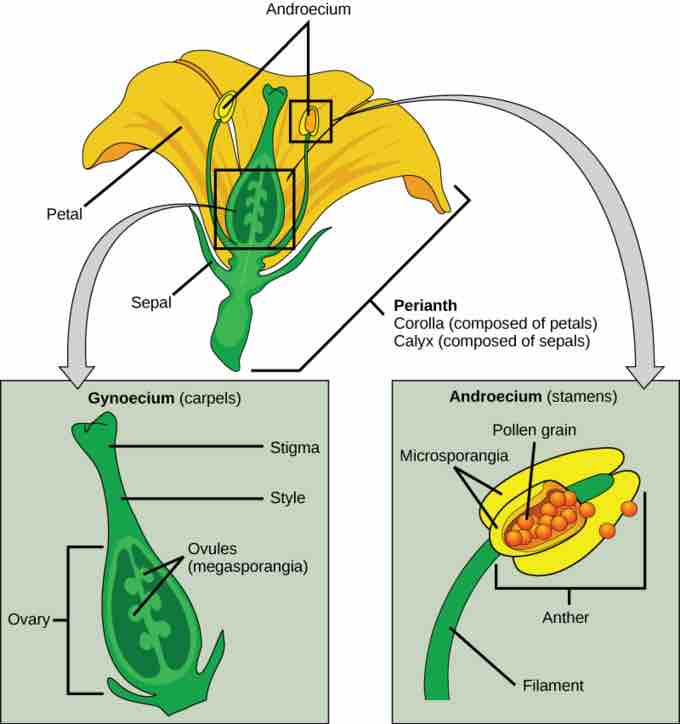
Structures of the flower
The four main parts of the flower are the calyx, corolla, androecium, and gynoecium. The androecium is the sum of all the male reproductive organs, and the gynoecium is the sum of the female reproductive organs.
If all four whorls are present, the flower is described as complete. If any of the four parts is missing, the flower is known as incomplete. Flowers that contain both an androecium and a gynoecium are called perfect, androgynous, or hermaphrodites. There are two types of incomplete flowers: staminate flowers contain only an androecium; and carpellate flowers have only a gynoecium .
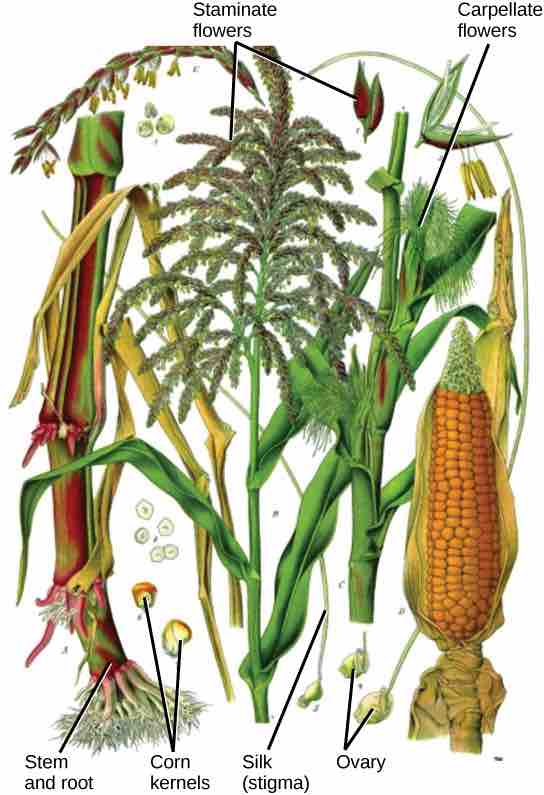
Staminate and carpellate flowers
The corn plant has both staminate (male) and carpellate (female) flowers. Staminate flowers, which are clustered in the tassel at the tip of the stem, produce pollen grains. Carpellate flower are clustered in the immature ears. Each strand of silk is a stigma. The corn kernels are seeds that develop on the ear after fertilization. Also shown is the lower stem and root.
If both male and female flowers are borne on the same plant (e.g., corn or peas), the species is called monoecious (meaning "one home"). Species with male and female flowers borne on separate plants (e.g., C. papaya or Cannabis)are termed dioecious, or "two homes." The ovary, which may contain one or multiple ovules, may be placed above other flower parts (referred to as superior); or it may be placed below the other flower parts (referred to as inferior) .
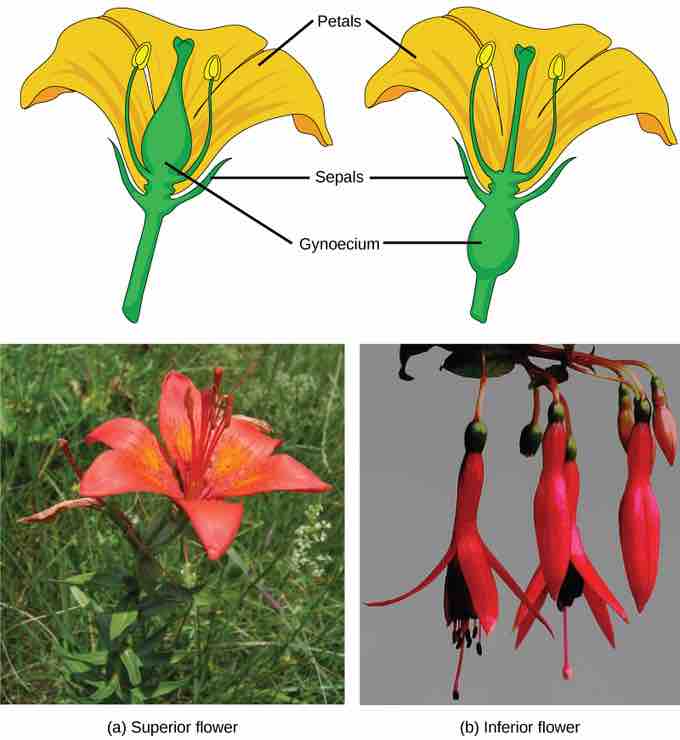
Superior and inferior flowers
The (a) lily is a superior flower, which has the ovary above the other flower parts. (b) Fuchsia is an inferior flower, which has the ovary beneath other flower parts.
Male Gametophyte
The male gametophyte develops and reaches maturity in an immature anther. In a plant's male reproductive organs, development of pollen takes place in a structure known as the microsporangium . The microsporangia, usually bi-lobed, are pollen sacs in which the microspores develop into pollen grains.
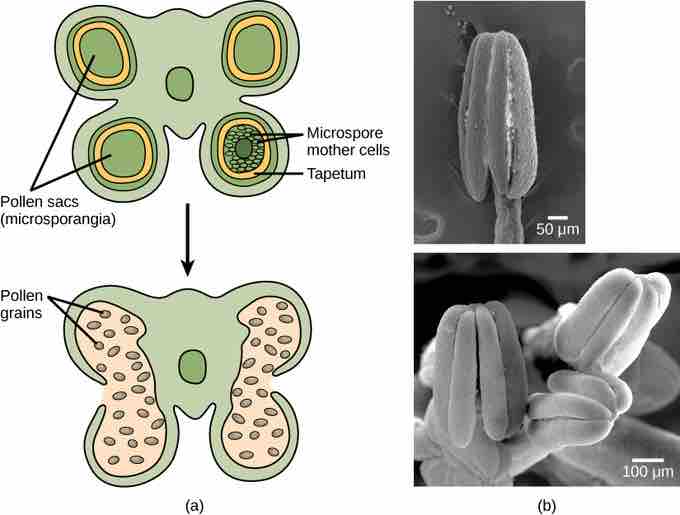
Microsporangium
Shown is (a) a cross section of an anther at two developmental stages. The immature anther (top) contains four microsporangia, or pollen sacs. Each microsporangium contains hundreds of microspore mother cells that will each give rise to four pollen grains. The tapetum supports the development and maturation of the pollen grains. Upon maturation of the pollen (bottom), the pollen sac walls split open and the pollen grains (male gametophytes) are released. (b) In these scanning electron micrographs, pollen sacs are ready to burst, releasing their grains.
Within the microsporangium, the microspore mother cell divides by meiosis to give rise to four microspores, each of which will ultimately form a pollen grain . An inner layer of cells, known as the tapetum, provides nutrition to the developing microspores, contributing key components to the pollen wall. Mature pollen grains contain two cells: a generative cell and a pollen tube cell. The generative cell is contained within the larger pollen tube cell. Upon germination, the tube cell forms the pollen tube through which the generative cell migrates to enter the ovary. During its transit inside the pollen tube, the generative cell divides to form two male gametes. Upon maturity, the microsporangia burst, releasing the pollen grains from the anther.
Each pollen grain has two coverings: the exine (thicker, outer layer) and the intine . The exine contains sporopollenin, a complex waterproofing substance supplied by the tapetal cells. Sporopollenin allows the pollen to survive under unfavorable conditions and to be carried by wind, water, or biological agents without undergoing damage.

Pollen grain structure
Pollen develops from the microspore mother cells. The mature pollen grain is composed of two cells: the pollen tube cell and the generative cell, which is inside the tube cell. The pollen grain has two coverings: an inner layer (intine) and an outer layer (exine). The inset scanning electron micrograph shows Arabidopsis lyrata pollen grains.
Female Gametophyte (Embryo Sac)
The overall development of the female gametophyte has two distinct phases. First, in the process of megasporogenesis, a single cell in the diploid megasporangium undergoes meiosis to produce four megaspores, only one of which survives. During the second phase, megagametogenesis, the surviving haploid megaspore undergoes mitosis to produce an eight-nucleate, seven-cell female gametophyte, also known as the megagametophyte, or embryo sac. The polar nuclei move to the equator and fuse, forming a single, diploid central cell. This central cell later fuses with a sperm to form the triploid endosperm. Three nuclei position themselves on the end of the embryo sac opposite the micropyle and develop into the antipodal cells, which later degenerate. The nucleus closest to the micropyle becomes the female gamete, or egg cell, and the two adjacent nuclei develop into synergid cells . The synergids help guide the pollen tube for successful fertilization, after which they disintegrate. Once fertilization is complete, the resulting diploid zygote develops into the embryo; the fertilized ovule forms the other tissues of the seed.
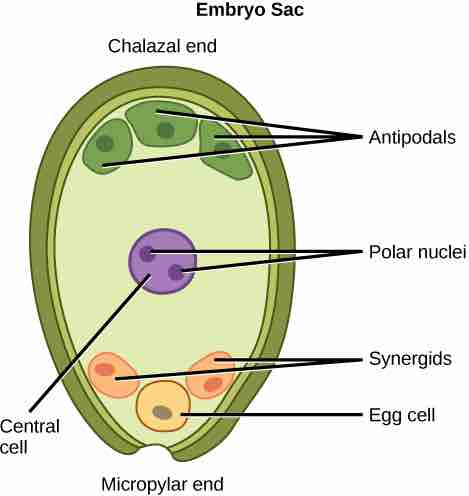
Embryo sac
As shown in this diagram of the embryo sac in angiosperms, the ovule is covered by integuments and has an opening called a micropyle. Inside the embryo sac are three antipodal cells, two synergids, a central cell, and the egg cell.
A double-layered integument protects the megasporangium and, later, the embryo sac. The integument will develop into the seed coat after fertilization, protecting the entire seed. The ovule wall will become part of the fruit. The integuments, while protecting the megasporangium, do not enclose it completely, but leave an opening called the micropyle. The micropyle allows the pollen tube to enter the female gametophyte for fertilization.